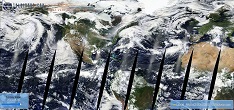MODIS VIIRS Global Coverage
Using an API for access to the data and some leaflet scripting, I have created a MODIS VIIRS live true color global imagery for you to view. On the page, you will see some gaps in coverage due to the MODIS coverage of 2290 km. Use the slider on the bottom left to scroll through imagery. Depending on the time of day you visit, my system may not have finished up loading the current days images.
Depending on the time of day determines what is shown on the screen, as the satellite is still making orbits to provide the data.
The Details
VIIRS is aboard two satellites: NASA/NOAA Suomi National Polar-orbiting Partnership (Suomi NPP) and NOAA-20. Suomi NPP, which contains five instruments including VIIRS, was launched from Vandenberg Air Force Base on October 28, 2011. It was the first in a series of four Joint Polar Satellite System (JPSS) satellites, a collaborative mission between NOAA and NASA, that carries the VIIRS instrument. The second JPSS satellite, NOAA-20, was launched into space on November 18, 2017. It is the first spacecraft of NOAA’s next generation of polar-orbiting satellites. NOAA-20 contains similar instruments as Suomi NPP including VIIRS. NOAA-20 circles the earth in the same orbit as Suomi NPP but is separated in time and space by 50 minutes, providing additional VIIRS coverage over previously captured areas by Suomi NPP, similar to how the Terra and Aqua satellites provide Moderate Resolution Imaging Spectroradiometer (MODIS) data. https://usradioguy.com/GLOBAL/VIIRS/
Individual Passes are retrieved and stitched together once per day using a script. Doing it more often offers no benefit as the passes (orbits) have not been completed and would yield a partial picture.
VIIRS observes the entire Earth’s surface twice each day crossing equator approximately 14 times each day per satellite. Suomi NPP crosses the equator about 1:30 a.m. and 1:30 p.m. and NOAA-20 crossing at 2:20 am and 2:20 pm, local time; from NPP’s polar orbit 824 kilometers (km) (512 miles) above the Earth’s surface. The 3,000 km swath width of the VIIRS instrument, which is 710 km greater than that of MODIS, allows for no gaps in coverage as observed in MODIS near the equator. The VIIRS instrument provides 22 spectral bands from 412 nanometers (nm) to 12 micrometers (µm) at two spatial resolutions, 375 meters (m) and 750 m, which are resampled to 500 m, 1 km, and 0.05 degrees in the NASA produced data products to promote consistency with the MODIS heritage.
Visible Infrared Imaging Radiometer Suite (VIIRS) data products are developed by the National Aeronautics and Space Administration (NASA) and are distributed by NASA’s Land Processes Distributed Active Archive Center (LP DAAC).
VIIRS’ spatial resolution (375m or 750m per pixel) is finer than the 1km to 2km resolution of most channels of the GOES-R Advanced Baseline Imager (ABI). VIIRS bands are near the 0.5km resolution of ABI’s Channel 2 (0.64µm).
Each VIIRS imagery channel measures radiances in a portion of the electromagnetic spectrum, from Visible to Near Infrared (IR), Short-, Medium-, and Long-wave IR.
As for timing, the NOAA-20, NOAA-21, and S-NPP satellites are on a low-earth, sun-synchronous orbit slightly more than 100 minutes long; each crosses the equator at 13:30 local solar time in the northbound direction (ascending node), and at 01:30 local solar time in the southbound direction (descending node). NOAA-20 and S-NPP are at opposite points on this orbit. NOAA-21 is directly between them, one quarter-orbit ahead of S-NPP. Together they provide VIIRS imagery for most of the globe at least six times per day (three in the daytime; three more at night). In mid- and northern latitudes, given the overlap among VIIRS swaths, many CONUS locations are sensed 8 or 9 times a day (between the three satellites); and parts of Alaska 16-20 times per day.

